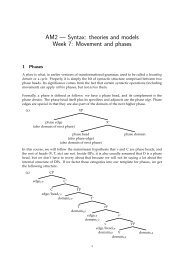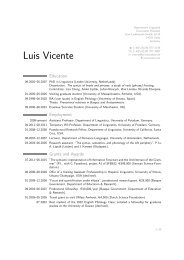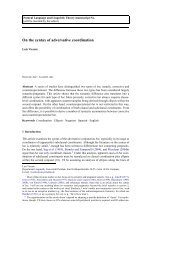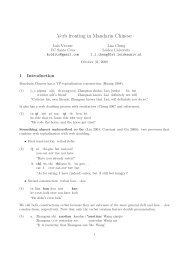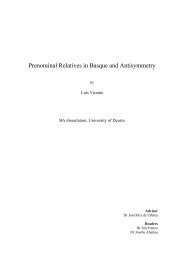Create successful ePaper yourself
Turn your PDF publications into a flip-book with our unique Google optimized e-Paper software.
8ELLIPSIS AND NEGATION IN SPANISH(focalised) subjects prefer a no XP continuation, whereas preverbal (non-focalised)ones prefer an XP no continuation. (example (26)d is my own).26) a. Vino Juan, pero no Pedrocame.3SG J but not Pb. # Juan vino, pero no PedroJ came.3SG but not Pc. Juan vino, pero Pedro noJ came.3SG but P notd. # Vino Juan, pero Pedro nocame.3SG J but P not2.5. Scope interactions2.5.1. ManyIn cases in which the remnant XP is a quantificational element, it is possible toobserve some variations in the scope it takes with respect to <strong>negatio</strong>n. Let us startwith muchos ‘many’. In negative replies, this quantifier <strong>and</strong> <strong>negatio</strong>n always takeonly linear scope.27) How many books have you read?a. Muchos no [many > 5 / * 5 > many]many notb. No muchos [* many > 5 / 5 > many]not manyThese readings can be made more salient if we add affirmative continuations. Thus,(28)a is a consistent statement. It means that, while there is a large number of booksthat I haven’t read, there is also an equally large number that I have read. In contrast,(28)b comes out as a contradiction. Since [5 > many] is logically equivalent to few,it states at the same time that I have read few books <strong>and</strong> that I have read manybooks.28) How many books have you read?a. Muchos no, pero muchos sí [valid statement]many not but many yesb. # No muchos, pero muchos sí [contradiction]not many but many yes
ELLIPSIS AND NEGATION IN SPANISH 9Interestingly, topicalisation <strong>and</strong> focalisation (whether fronting or in situ) also derivethe wide scope reading of many, which is impossible under a neutral interpretationof the sentence. 829) a. No he leido muchos libros [* many > 5 / 5 > many]not have read many booksb. Muchos libros, no los he leido [many > 5 / * 5 > many]many books not CL have readc. No he leido MUCHOS LIBROS [many > 5 / * 5 > many]not have read many booksd. MUCHOS LIBROS no he leido [many > 5 / * 5 > many]many books not have readLet us assume that foci in situ (29)c are actually moving at LF to a left-peripheralposition (e.g., Chomsky 19??, Jackendoff 1972). If so, we can generalise, on thebasis of (29), that many may scope over <strong>negatio</strong>n only if it sits in a higher structuralposition, either in narrow syntax or at LF. Extending this generalisation to theexamples in (27), we can conclude that, in XP no orders, the remnant XP movesover <strong>negatio</strong>n, whereas this is not the case in no XP orders. In particular, thestrongest conclusion would be that it doesn’t move over <strong>negatio</strong>n at any level ofrepresentation, since that would license the [many > 5] reading. Thus, a tentativeconclusion is that the no we see in negative fragments might be a different elementfrom the no in full negative clauses.2.5.2. AllThe universal quantifier todos ‘all’ shows a slightly different behaviour. As can beseen, it always takes scope below <strong>negatio</strong>n, in spite of the linear order.30) How many books have you read?a. Todos no [* ∀ > 5 / 5 > ∀]all notb. No todos [* ∀ > 5 / 5 > ∀]not allNonetheless, I think this can be safely attributed to the general tendency of universalquantifiers not to outscope <strong>negatio</strong>n. As (31)b shows, a topicalised universal objectis preferably interpreted below <strong>negatio</strong>n.31) a. No he leido todos los libros [* ∀ > 5 / 5 > ∀]not have read all the booksb. Todos los libros, no los he leido [?? ∀ > 5 / 5 > ∀]all the books not CL have read8 This doesn’t hold for subjects. Given that TP is higher than NegP, regular A movement to SpecTP c<strong>and</strong>erive the wide scope reading without resorting to any topic/focus effects. To control for this, I onlyconsider object quantifiers.
10ELLIPSIS AND NEGATION IN SPANISHIn (32)a <strong>and</strong> (32)b, where focalisation seems to force a wide scope interpretation ofthe object, we get degraded sentences.32) a. ?? No he leido TODOS LOS LIBROSnot have read all the booksb. ?? TODOS LOS LIBROS no he leidoall the books not have readThis is also an effect present in A movement. As shown in (33), there is also atendency for a universal subject to scope below <strong>negatio</strong>n. To the (rather marginal)extent that the subject can take wide scope, it must be from a preverbal position.33) a. Todos los estudiantes no aprobaron el examenall the students not passed the exam[?? ∀ > 5 / 5 > ∀]b. No aprobaron todos los estudiantes el examennot passed all the students the exam[* ∀ > 5 / 5 > ∀]I think that, even in the light of these data, we can maintain our previousgeneralisation that wide scope over <strong>negatio</strong>n can only be derived by movement to ahigher position. Example (30)b does not challenge it since, as we have seen here,wide scope of a universal quantifier over <strong>negatio</strong>n is generally quite degraded. Thisconclusion is confirmed by the following data. As shown in (34) for topic <strong>and</strong> focus,<strong>and</strong> in (35) for A movement, wide scope of the universal is possible if the QP picksup a subset of a larger set.34) a. Which books have you read?b. Todos los libros con una marca azul, no los he leidoall the books with a mark blue not CL have read[∀ > 5 / 5 > ∀]c. TODOS LOS LIBROS CON UNA MARCA AZUL no he leidoall the books with a mark blue not have read[∀ > 5 / 5 > ∀]d. No he leido TODOS LOS LIBROS CON UNA MARCA AZULnot have read all the books with a mark blue[∀ > 5 / 5 > ∀]35) a. Who failed the exam?b. Todos los que estudian historia no han suspendido el examenall the that study history not have failed the exam[∀ > 5 / 5 > ∀]c. No han suspendido todos los que estudian historia el examennot have failed all the that study history the exam[*∀ > 5 / 5 > ∀]
ELLIPSIS AND NEGATION IN SPANISH 11Unsurprisingly, in this case it is also possible to get a [∀ > 5] reading in an XP noreply, though not in a no XP reply.36) a. Which books have you read?b. Todos los libros con una marca azul no [∀ > 5 / 5 > ∀]all the books with a mark blue notc. No todos los libros con una marca azul [*∀ > 5 / 5 > ∀]not all the books with a mark blueIn short, we keep the same conclusion as in the previous subsection: scope of thequantifier over <strong>negatio</strong>n is only possible if the quantifier moves to a higher positionthan <strong>negatio</strong>n.2.5.3. Elided circumstantial mustConsider a full sentence like (37), <strong>and</strong> the interaction between <strong>negatio</strong>n <strong>and</strong> thenecessity modal deber ‘must’ (~). 9 Although this type of sentences are scopallyambiguous, there is a preference for the reading with wide (inverse) scope of themodal. To my ear, the direct scope reading is the secondary one, even in scenariosthat, in principle, should bring it out. This is evident in the dialogue in (38), wherewe have a contextual bias in favour of the [5 > ~] reading. Even in spite of this, theinverse scope reading is still preferred. Similarly, the primary reading of (39) is theimprobable one in which Juan will not get his degree if he takes any more courses. 1037) a. Juan no debe llevar corbataJ not must wear tieb. ~ > 5 (there is an obligation for him not to wear a tie)c. ? 5 > ~ (it is not required that he wears a tie)38) a. Si vamos a salir, me pondré otra ropa mejorif we are going out, I’ll change into fancier clothes9 The counterpart of this example in German(ic) has been described as being ambiguous, <strong>and</strong> even with apreference for <strong>negatio</strong>n taking wide scope (cf. Penka & Zeijlstra 2005). The difference could come fromthe fact that, in the German example, <strong>negatio</strong>n is part of an indefinite object, rather than sentential<strong>negatio</strong>n. This also complicates the example, in that kein consists of <strong>negatio</strong>n plus an existentialquantifier, which can take scope independently of each other. Thus, (i) is three-way ambiguous. Thiscomplication does not arise in the Spanish examples, where I avoid using quantificational objects.i) Du musst [keine Krawatte] anziehen [~ > 5 > ∃/ 5 > ~ > ∃ / 5 > ∃ > ~]you must no tie wear10 For completeness, here is the one example I’ve been able to construct with where the [5 > ~] readingcomes out with reasonable ease. Still, the [~ > 5] reading is just as prominent as above.i) Si algo es gratis, significa que no debes pagarif something is for free means that not must.2SG pay
12ELLIPSIS AND NEGATION IN SPANISHb. Sólo vamos al bar de la esquina a tomar unas cañaswe are just going to the bar around the corner for a few beersNo debes ponerte corbatanot must.2SG put on tie[~ > 5 / ? 5 > ~]39) a. Juan ya tiene todos los créditos que necesita.Juan has already done all required courseworkb. Para sacarse el título, no debe coger más clasesso as to receive the degree not must take more courses[~ > 5 / ? 5 > ~]Now consider what happens under <strong>ellipsis</strong>. In (40)b, the [5 > ~] reading is perfectlyfine, alongside the original [~ > 5].40) a. ¿Qué tipo de ropa debe llevar Juan en su boda ?what kind of garments must wear J at his weddingb. Corbata notie not[~ > 5 / 5 > ~]This is also the case for no XP orders. Compare the two examples below. Example(41)b is consistent with a situation in which, to get the scholarship, it is not requiredfor Juan to say that he wants to write a thesis about participles. Note that this is anexample of matrix <strong>negatio</strong>n, so it is not possible to say that no XP starts off as aconstituent downstairs (cf. Depiante 2000:IV).41) Para que le den la beca…so as to get the scholarship…Juan no debe decir que quiere escribir una tesis sobre los participiosJ not must write that wants write a thesis about the participles[~ > 5 / ??? 5 > ~]42) a. Para que le den la beca…so as to get the scholarship…¿Sobre qué tema debe decir Juan que quiere escribir su tesis?about what topic must say J that wants write his thesisb. No sobre los participiosnot about the participles[~ > 5 / 5 > ~]At this point, I’m not really sure about what the exact analysis of this paradigmshould be. Nonetheless, here is a possible direction. Following the hypothesis of thetwo previous subsections, we can say that, in full sentences, deber appears in ahigher position than <strong>negatio</strong>n at LF. Whether this happens by covert movement ofthe modal or by reconstruction of <strong>negatio</strong>n, that is something I don’t have anythingto say about as of now. The point, though, is that this will result in the modal
ELLIPSIS AND NEGATION IN SPANISH 13outscoping <strong>negatio</strong>n in full sentences. The wide scope reading of <strong>negatio</strong>n wouldthen be a consequence of such process (modal raising/<strong>negatio</strong>n reconstruction)failing to happen.Now, suppose –as mentioned at the end of section 2.5.1- that the <strong>negatio</strong>n thatappears in negative fragments is not the same one as the one in regular sentences.Rather, it is a head high in the left periphery (whereas regular <strong>negatio</strong>n issomewhere in the inflectional domain). If so, one can explain why the [5 > ~]reading comes out so much more easily in negative fragments. Being that high, itcan c-comm<strong>and</strong> the modal <strong>and</strong> take wide scope over the modal. However, this raisesthe question of how to derive the [~ > 5] reading, which is also available infragments.3. Topics, foci, questions, <strong>and</strong> answersIn the previous section I argued that the remnant XP in [XP no] replies sits in a topicposition. This is a rather strange conclusion at first sight, since replies to questionsare usually taken to be foci, not topics. As a matter of fact, short negative replies, in<strong>and</strong> of themselves, are a strange construction in pragmatic terms. An answer consistsessentially of a proposition containing a variable corresponding to the wh- word inthe question. The act of answering boils down to choosing a specific value for thevariable out of all possible alternatives. In negative replies, however, what one doesis to select a value <strong>and</strong> state that that value does not yield a true sentence. The valuethat returns a true sentence cannot be inferred from a negative reply. So, in a sense, anegative reply is not a proper answer to a question.In this section, I want to tie this observation to another property of shortnegative replies not mentioned so far, namely, the impossibly of uttering them out ofcontext. Suppose that a friend calls asking me (43)a. In this situation, (43)b <strong>and</strong>(43)c are not felicitous answers. In fact, for this paradigm, one gets the strongimpression that it has been already established in some way (i.e., by commonbackground, a previous conversation, or similar) that Match Point is one of the filmsthat are showing this evening. 11 For instance, the same replies are fully felicitous inthe context of (44).43) a. Do you want to go <strong>and</strong> see a film in the evening?b. # Match Point noM P notc. # No Match Pointnot M P44) a. This evening they are showing Match Point, Broken Flowers, <strong>and</strong> Jarhead.Do you want to see any of them?b. Match Point noM P not11 This holds for all short negative replies in this article.
14ELLIPSIS AND NEGATION IN SPANISHc. No Match Pointnot M PThis effect is not exclusive of short replies, though. Erteschik-Shir (1998:III) arguesin fact that it holds for all negative predicates. She points out that (45)b is not apossible answer to (45)a unless it is already established that going to the movies isone of the things that Joan might have done the previous night.45) a. What did Joan do last night?b. # She didn’t go to the movies.Given how negative predicates behave in discourse, it is possible to underst<strong>and</strong> whyshort negative replies target a topic position. Since what is being negated hasnecessarily been mentioned previously, referring back to it qualifies as marking it asa topic (understood as old/known information that is given discourse prominence).Hence, when moving to the left periphery, it targets a topic position.Now, the careful reader might have noticed that this analysis raises theopposite question. That is, if the remnant XP in a short reply is a topic, what is oneto do with [no XP] replies, which I have argued target a focus position? For one,recall that they are also infelicitous if uttered out of context, so they are clearly notinstances of new-information focus. Rather, it seems like they are cases ofcontrastive focalisation, in which the remnant XP is opposed to something else. Thisis a plausible option, I believe, as it would tie in with the presuppositional effectsdiscussed in section 2.4. Since the remnant XP is being contrasted with somethingelse, it follows that one cannot deny the existence of that something else, as in (22)b<strong>and</strong> (23)b. In fact, given that this effect also arises in the full sentences in (24) <strong>and</strong>(25), it can also be considered a general property of negative predicates, not just ofnegative replies.4. Towards an analysis4.1. A simple analysisRecall that, from the presupposition of existence effects (section 2.4) we concludedthat remnant XPs occupy a focus position in no XP orders <strong>and</strong> a topic position in XPno orders. That gives us a structure with a topic projection dominating a focusprojection, with <strong>negatio</strong>n s<strong>and</strong>wiched in between. The latter, I will call ΣP, afterLaka’s (1990) projection for polarity.
ELLIPSIS AND NEGATION IN SPANISH 1546) The left periphery in negative repliesTopPeiTopicΣPeinoFocPeiFocus ……This captures the basics of the construction. In no XP orders, the remnant XP movesto the focus position <strong>and</strong> <strong>negatio</strong>n is base generated above it. This captures theobservations that, in these replies, the remnant XP gives rise to presuppositions.Also, since <strong>negatio</strong>n is base generated so high, we derive that it must have widestscope reading. Finally, the impossibility of multiple remnants can be linked to therebeing a unique focus position in the clause. Thus, we get the structure in (47)c,where the curved line marks the domain of <strong>ellipsis</strong>.47) a. ¿Con quién ha ido Juan al cine?with who has gone J to the moviesb. No con Maríanot with Mc. ΣPqpnoFocPqp[con María]TP6Juan ha ido al cine tIn contrast, in XP no replies, the remnant XP moves to a topic position above ΣP.Since, as shown in 2.4, topics do not create presuppositions, we derive the fact thatXP no replies do not either. Moreover, we can also account for the fact that theremnant XP takes scope over <strong>negatio</strong>n, while <strong>negatio</strong>n still scopes over the elidedmaterial (section 2.5). Finally, since one clause may have multiple topic positions,we derive the possibility of multiple remnants (<strong>and</strong> their relatively free ordering) inXP no replies. Thus, we get the derivation in (48)c.48) a. ¿Con quién ha ido Juan al cine?with who has gone J to the moviesb. Con María nowith M not
16ELLIPSIS AND NEGATION IN SPANISHc. TopPqp[con María]ΣPqpnoTP6Juan ha ido al cine tHowever, this analysis, as it is, doesn’t predict the ungrammaticality of XP no YPfragments, as in (21), repeated below.21) a. ¿A dónde llegaron tarde todos tus amigos?to where arrived late all your friendsb. ?* María no al trabajoM not for workNonetheless, this example might be excluded for independent reasons. For one, notethat the following two variants are grammatical.49) a. María no sólo al trabajoM not only for workb. María ni siquiera al trabajoM not even for workWhen the post-<strong>negatio</strong>n XP is associated with focal elements like only or even, theexamples become acceptable. One way to interpret this is by capitalising in thehypothesis that the post-<strong>negatio</strong>n position is a focus position. Now, suppose that thetype of question in (21)a requires an answer where both the subject <strong>and</strong> the objectare topical. If so, the ungrammaticality of (21)b can be reduced to trying to stick atopic in a focus position. Support for this hypothesis comes from the observationthat another possible answer involves both remnant XPs in pre-<strong>negatio</strong>n (i.e., topic)position.50) María al trabajo noM for work notIn fact, even (21)b seems to become more acceptable if heavy stress is placed in the<strong>negatio</strong>n <strong>and</strong> the post-<strong>negatio</strong>n remnant. This example seems to require a contrastivecontinuation to be acceptable, but in any event, this seems to be a consequence ofthe same presuppositional effect reviewed in section 2.4.51) ? María, # NO AL TRABAJO (sino al cine)M not for work but for the movies
ELLIPSIS AND NEGATION IN SPANISH 17Finally, note that these replies are possible in embedded clauses, in all casesfollowing the complementiser que ‘that’. This suggests that the structure in (46)must be below the C head hosting that complementiser.52) a. Who do you think that Juan has gone to the movies with?b. Me parece que no con Maríame.DAT seems that not with Mc. Me parece que con María nome.DAT seems that with M not53) A slightly exp<strong>and</strong>ed left peripheryCPeique TopPeiTopicΣPeinoFocPeiFocus …4.2. Extra thoughts on fragments <strong>and</strong> constituent <strong>negatio</strong>nMy analysis, as sketched above, assumes that all no XP replies have the same form,namely, movement of the remnant XP to a focus position <strong>and</strong> base generation of<strong>negatio</strong>n in ΣP. The alternative, as proposed by Depiante (2000), is that no XP startsoff like that in the base position <strong>and</strong> simply moves to the left periphery as a unit.Now, it is clear that this cannot be the whole story, <strong>and</strong> that the type of derivation Ihave proposed is necessary to account for cases, like (15) <strong>and</strong> (16), where <strong>negatio</strong>n<strong>and</strong> the remnant XP originate in different clauses, hence they cannot form aconstituent. The question remains, though, as to whether all no XP replies can beformed in the way I have suggested, or whether one needs a mixed system, in whichsome of these fragments are formed according to Depiante’s hypothesis.This might have repercussions for the analysis of constituent <strong>negatio</strong>n.Consider, for instance, the following examples. In (54)a, we can see that the no conSusana ‘not with Susana’ fragment does not allow a high reading of <strong>negatio</strong>n –i.e.,there is only one event of saying, not two. Further, this fragment does not allow theXP no order (55)a. 12 The addition of pero ‘but’ changes the entire situation.Suddenly, the high reading of <strong>negatio</strong>n emerges (54)b, <strong>and</strong> the XP no order becomespossible (55)b. A straightforward way to interpret this paradigm is to say that thefragment in (54)a/(55)a is not the result of <strong>ellipsis</strong>. Rather, it is a simple PP with<strong>negatio</strong>n attached on top, <strong>and</strong> nothing else. Thus, no high reading of <strong>negatio</strong>n <strong>and</strong> noXP no orders, since both require higher structure that wouldn’t be present here. In12 It is possible to force this example into grammaticality, but then I get the feeling that there are with twoseparate sentences, the second one, then, being a regular elliptical XP no fragment.
18ELLIPSIS AND NEGATION IN SPANISHcontrast, the use of pero allows for coordination at the clausal level, which entailsthat the fragments in (55)b <strong>and</strong> (55)b are elliptical.54) a. Dijiste que ibas a ir al cine con María, no con Susanasaid.2SG that were going to the movies with M not with S[≠ you didn’t say that you were going with Susana]b. Dijiste que ibas a ir al cine con María,said.2SG that were going to the movies with Mpero no con Susanabut not with S[= you didn’t say that you were going with Susana]55) a. * Dijiste que ibas a ir al cine con María, con Susana nosaid.2SG that were going to the movies with M with S notb. Dijiste que ibas a ir al cine con María,said.2SG that were going to the movies with Mpero con Susana nobut with S noSo, suppose there is a possibility of adjoining <strong>negatio</strong>n to any given constituent <strong>and</strong>then using it as a fragment (as Depiante proposes) is generally available. Then, itcould be the case that no XP fragments can be formed in two ways, i.e., Depiantestyle<strong>and</strong> in the way I have proposed in (46). Whenever a high reading of <strong>negatio</strong>n isnecessary, that would force the use of my analysis, but otherwise, either one woulddo. This seems to be supported by Bianchi & Zamparelli’s (2003) observation that itis possible to from the [no XP] fragment <strong>and</strong> its associate together as a constituent.56) a. He invited not Mary, but Lucyb. [Not Mary, but Lucy], he decided to invite.In Spanish, such fronting is only possible with [no XP] orders. This confirms thatreplies like (54)a consist of a coordination of just the negative fragment <strong>and</strong> itsassociate, without <strong>ellipsis</strong>. In contrast, the ungrammaticality of (57)b follows if [XPno] fragments require full clausal coordination plus <strong>ellipsis</strong>. Under such a structure,[con María] <strong>and</strong> [con Susana no] wouldn’t form a constituent, hence it would beimpossible to front them together.57) a. ? [Con María, (y) no con Susana] dijiste que fuiste al cinewith M <strong>and</strong> not with S said.2SG that went.2SG to the moviesb. * [Con María, con Susana no] dijiste que fuiste al cinewith M with S not said.2SG that went.2SG to the moviesNote also that (57)a is quite degraded if pero ‘but’ is added. This shows that peroforces clausal coordination, as suggested above.58) ?* [Con María, pero no con Susana] dijiste que fuiste al cinewith M but not with S said.2SG that went.2SG to the movies
ELLIPSIS AND NEGATION IN SPANISH 19For constituent <strong>negatio</strong>n, the question is what the relation is between the fragment<strong>and</strong> its associate. I propose that they form a coordinate structure, since it is possibleto include y ‘<strong>and</strong>’ between the two of them. Unlike pero, the addition of <strong>and</strong> doesnot license the high reading of <strong>negatio</strong>n, or XP no orders.59) a. Juan ha dicho que ha leido un libro, (y) no una revistaJ has said that has read a book <strong>and</strong> not a magazine[≠ he hasn’t said he has read a magazine]b. * Juan ha dicho que ha leido un libro, (y) una revista noJ has said that has read a book <strong>and</strong> a magazine notA related issue comes from the example like the one below, where the fragment isextraposed (note that this example requires stress on al cine ‘to the movies’ to markthat this is the phrase the fragment is associating with).60) Juan ha ido AL CINE con María, (y) no al teatroJ has gone to the movies with M <strong>and</strong> not to the theatreThis would be an example of a non-elliptical fragment, since, for instance, it doesn’tallow the XP no order. Note also the optional presence of y ‘<strong>and</strong>’ (which is alsopossible in (54)a <strong>and</strong> (55)a above, so the discussion here is extensible to thoseexamples). On the basis of this coordinator, we may suppose that constituent<strong>negatio</strong>ns like this are always instances of coordination, with the quirk that thecoordinator need not be overt. If so, then the question arises as to how to analyse(61). One cannot simply say that the fragment is dislocated, since then that shouldresult in a CSC violation. So, the one possibility left is to say that there is a small<strong>ellipsis</strong> inside the fragment, e.g.,61) Juan ha ido [[ AL CINE con María], (y) [no al teatro con María]]J has gone to the movies with M <strong>and</strong> not to the theatre with MHowever, since the associate of the fragment can itself be dislocated as well, thatwould force us into larger <strong>and</strong> larger ellipses within the fragment. Since at a certainpoint we would have to start resorting to dislocation of the remnant XP, thissuggests that constituent <strong>negatio</strong>n as well can derive from two sources. In fact, suchderivations are also defended by Bianchi & Zamparelli (2003).62) [[AL CINE ha dicho Juan que ha ido con María]to the movies has said J that has gone with M[(y) no al teatro [ha dicho Juan que ha ido t con María]]]<strong>and</strong> not to the theatre has said J that has gone with M
20ELLIPSIS AND NEGATION IN SPANISH5. Affirmative short repliesSo far, I have only considered short replies with <strong>negatio</strong>n in them. However, it isalso possible to substitute <strong>negatio</strong>n for the affirmative particle sí ‘yes’. 13 Theinterpretation of such examples is similar to that of English VP <strong>ellipsis</strong>.63) a. Apparently, no student managed to pass the examb. Juan síJ yes“Juan did (manage to pass the exam)”Affirmative replies are different from bare replies, which have just a remnant XP,without any polarity-related element. For one, only bare replies can be used asanswers to wh- questions, as shown below. The [XP sí] reply can only be used if it iscontrasted with a negative predicate/reply.64) a. Who managed to pass the exam?b. JuanJc. * Juan síJ yesd. Juan sí; Pedro noJ yes P notIn contrast, both types of replies are fine as answers to yes-no questions. Note,however, that [XP sí] replies are only felicitous in case (a) they cancel an existentpresupposition or (b) they are used in contrast to something. In this sense, theyparallel to (63)b. Example (63)b is not restricted in this way, <strong>and</strong> it is the unmarkedway of answering such a question.65) a. Did anybody come to the party?b. JuanJc. Juan síJuan yes (even though it seemed like he wasn’t going to)d. Juan sí; Pedro noJ yes P notIn this respect, it seems like affirmative replies pattern together with negative repliesin that they can only be uttered in specific contexts, i.e., whenever the remnant XP ispart of the common discourse background. Now, an intriguing difference betweenaffirmative <strong>and</strong> negative short replies is that the former, in contrast with the latter,do not seem to allow a [sí XP] order –or, at least, only very marginally. Thus, (66)a13 Not to be confused with si ‘if’ –there is no accent mark in the latter. This is a bit on a nuisance forinternet searches, since Google does not recognise accent marks, <strong>and</strong> lumps sí <strong>and</strong> si together.
ELLIPSIS AND NEGATION IN SPANISH 21by itself is not a possible reply to (65)a, although it is much better it there is anegative predicate to establish a contrast with.66) a. *? Sí Juanyes J“Juan did (come to the party)”b. ? No ha venido Pedro, pero sí Juannot has come P but yes JIn fact, the [sí XP] order is acceptable only when used as a contrast with a previousnegative statement. Consider the following examples, taken from a Google searchfor exact sí con ‘yes with’ strings.67) a. No me deja navegar con Firefox, pero sí con KonquerorNot me.DAT lets browse with F but yes with K“(My computer) doesn’t let me surf the net with Firefox, but it doeswith Konqueror” 14b. Quien comete un delito tipificado con excomunión sewho commits a crime punished with excommunication SEcoloca fuera de la Iglesia, no con las palabras, peroplaces outside of the church not with the words butsí con los hechosyes with the facts“Whoever commits a crime punished with excommunication is nolonger within the (Catholic) Church, not just nominally, but for allintents <strong>and</strong> purposes” 15c. Algunos pacientes inician la enfermedad sin temblor,some patients start the disease without shakingpero sí con depresiónbut yes with depression“At the early stages of the disease (Parkinson), some patients don’tsuffer yet from shaking h<strong>and</strong>s, but still they feel depressed” 16d. A mi no me gustaría [encamarme] con una marciana,to me not me.DAT like sleep with a martian.FEMpero a ellos sí con una mujerbut to them yes with a woman“I wouldn’t like to sleep with a Martian woman, but I bet Martianswould like to sleep with an Earth woman” 17We conclude, then, that [XP no] <strong>and</strong> [XP sí] replies are similar in that they bothrequire the remnant XP to be part of the common discourse background. In thephrase structure developed here, this is implemented by positing a topic positionabove ΣP. In contrast, the [no XP] <strong>and</strong> [sí XP] orders both require the existence of a14 http://www.kdehispano.org/node/237715 http://www.iuscanonicum.org/articulos/art187.html16 http://www.sinapsis.org/neuropsiquiatria.html17 http://axxon.com.ar/rev/122/c-122LasMujeres.htm. Argentinians are like this.
22ELLIPSIS AND NEGATION IN SPANISHcontrast for the remnant XP. The difference, which I don’t underst<strong>and</strong> yet, is thataffirmative replies seem to have a much stronger preference for the contrast to beexplicit, in contrast to their negative counterparts, where the contrast can be leftimplicit with greater frequency.6. ReferencesBianchi, Valentina, <strong>and</strong> Roberto Zamparelli (2003), “Edge coordinations: focus <strong>and</strong> conjunctionreduction”, in Adger et al (eds.), Peripheries, Kluwer, Dordrecht.Bosque, Ignacio (1984), “Negación y elipsis”, Estudios de lingüística de la Universidad de Alicante 2,171-199.Brucart, José (1987), La elisión sintáctica en español, Bellaterra, Barcelona.Brucart, José (1999), “La elipsis”, in Bosque & Demonte (eds.), Gramática descriptiva de la lenguaespañola, Espasa-Calpe, Madrid.Depiante, Marcela (2000), The syntax of deep <strong>and</strong> surface anaphora: a study of null complementanaphora <strong>and</strong> stripping/bare argument <strong>ellipsis</strong>, PhD dissertation, University of Connecticut.Depiante, Marcela (2001), “Ellipsis in Spanish <strong>and</strong> the Stray Affix Filter”, Proceedings of NELS 31.Erteschik-Shir, Nomi (1998), The dynamics of focus structure, Oxford University Press, Oxford.Laka, Itziar (1990), Negation in syntax, PhD dissertation, MITMcCawley, James (1991), “Metalinguistic <strong>negatio</strong>n <strong>and</strong> contrastive <strong>negatio</strong>n”, Proceedings of CLS 27:parasession on <strong>negatio</strong>n.Merchant, Jason (2003), “Remarks on stripping”, ms., University of Chicago.Merchant, Jason (2004), “Fragments <strong>and</strong> <strong>ellipsis</strong>”, Linguistics <strong>and</strong> Philosophy.Morgan, Jerry (1973), “Sentence fragments <strong>and</strong> the notion of ‘sentence’”, in Kachru et al (eds.), Issues inlinguistics, University of Illinois Press, Urbana-Champaign.Penka, Doris, <strong>and</strong> Hedde Zeijlstra (2005), “Negative indefinites in Dutch <strong>and</strong> German”, ms., Universityof Tübingen.Contact<strong>Luis</strong> <strong>Vicente</strong>Leiden University Centre for LinguisticsP.O. Box 95152300 RA LeidenNetherl<strong>and</strong>skoldito@gmail.comhttp://www.luisvicente.net



